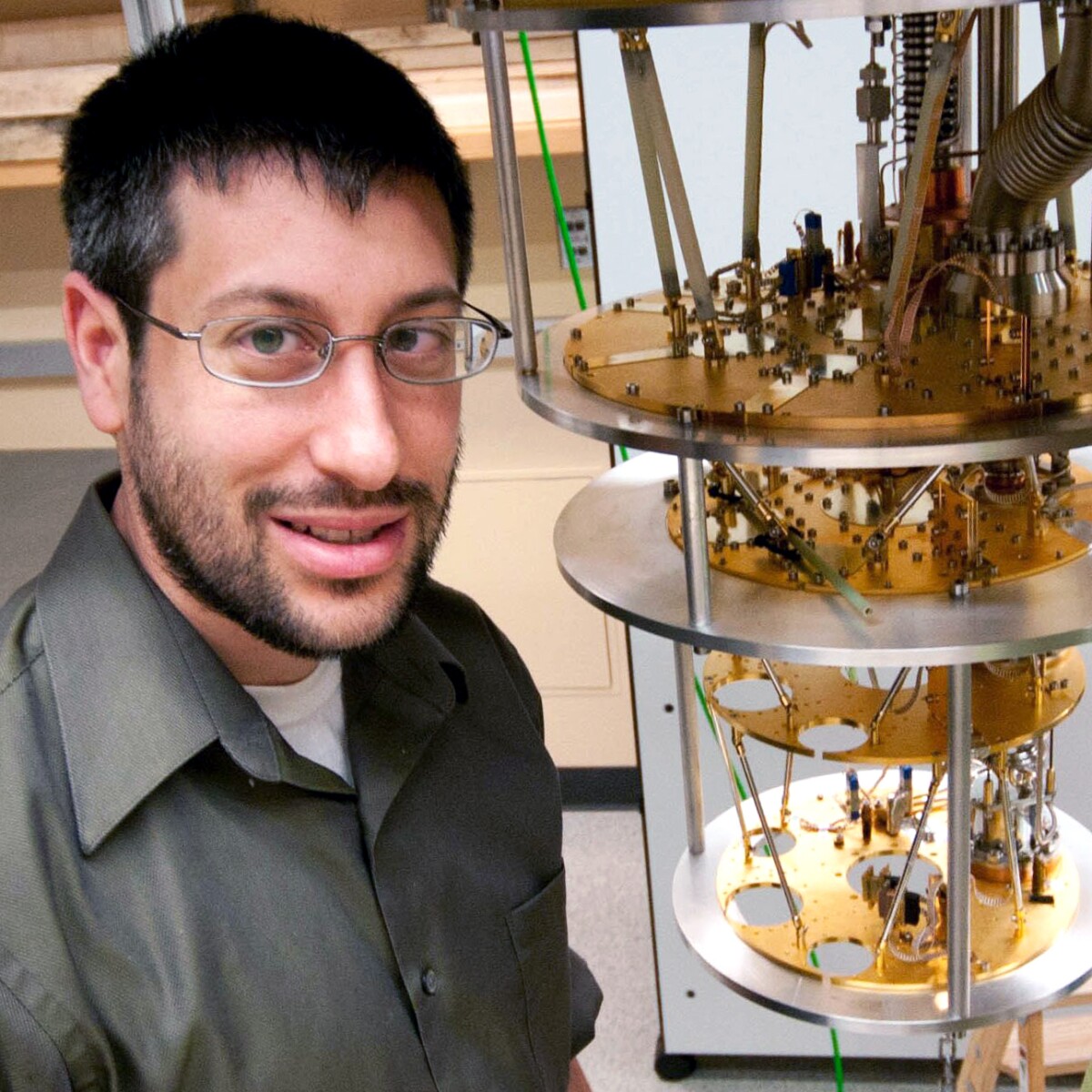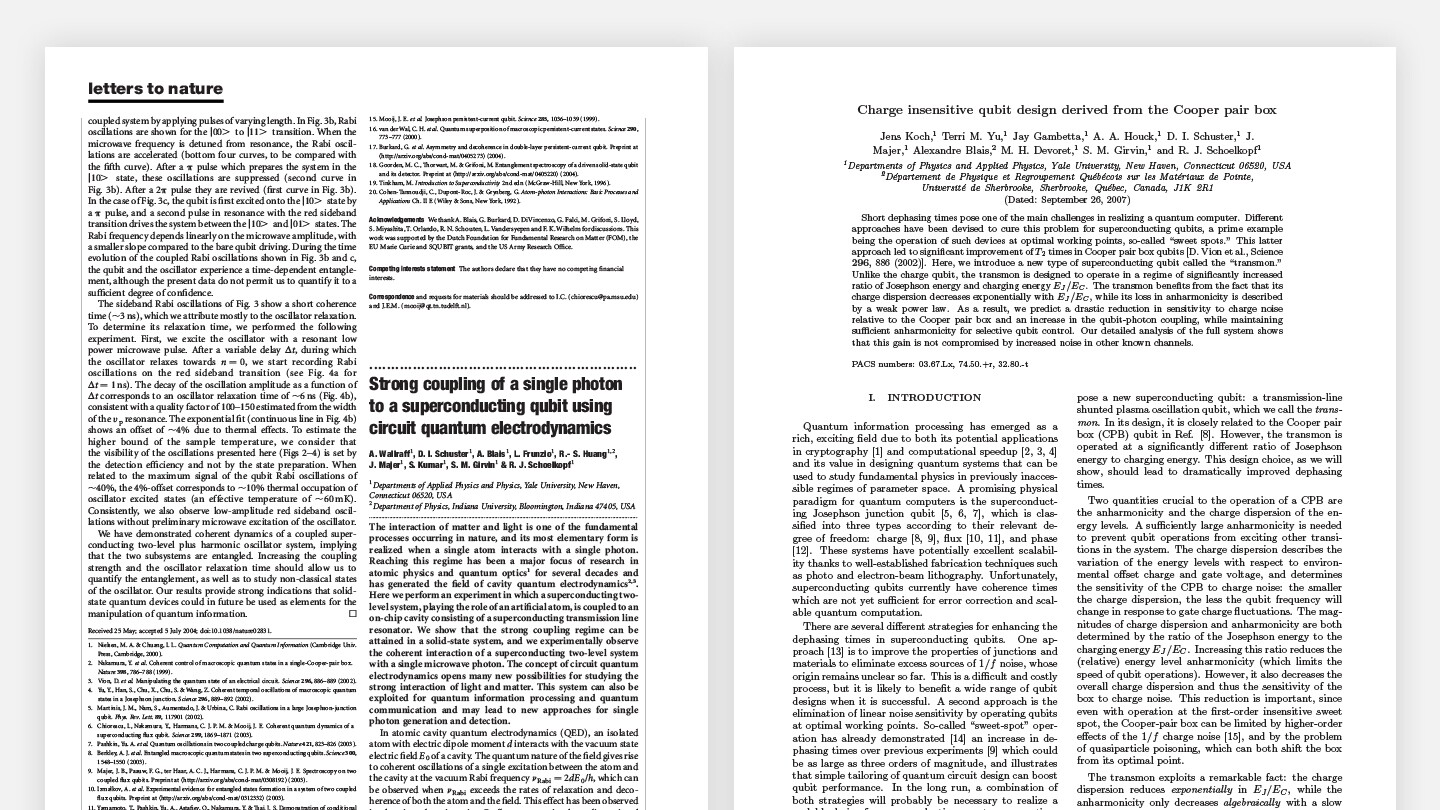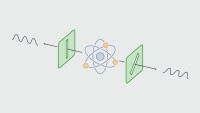To become a foundational player in the creation of a potentially world-changing technology requires the happy conjunction of talent and timing. Both can be found in physicist David Schuster, who is pioneering the technology underpinning quantum computers.

Schuster became an Amazon Scholar in October 2020, joining the newly established AWS Center for Quantum Computing. Passionate about computers and physics, it was during Schuster’s undergrad studies at Brown University in the early 2000s that he became aware of the nascent field of quantum computing.
“As soon as I heard about it, I was taken with the idea that I could be involved in building a completely new type of computer,” says Schuster. He saw this chance for what it was, a colossal stroke of right-place-right-time good fortune. “The opportunity to make an impact at such a fundamental level was very exciting.”
To appreciate why quantum computing has such potential, compare it to regular, or “classical”, computers. A classical computer uses digital bits to perform computations, with each bit representing either 0 or 1 at any given time. In simplistic terms, increasing the number of bits available to interact with each other increases the computational power of a computer in an additive, linear fashion. A top-end laptop will boast 32 gigabytes of RAM, which is 256,000,000,000 bits.
A quantum computer, by contrast, uses quantum bits (qubits) to perform calculations. Each qubit can be in a simultaneously 0 and 1 at any given time. As a result of this “quantum superposition” – which only occurs at the tiniest scales – increasing the qubits results in an exponential explosion in computational power. It is estimated that a fully functional quantum computer with as little as 100 qubits could outsmart today’s most powerful supercomputers for appropriately chosen problems.
Because of the tiny scale and extreme conditions at which qubits exist, it is very difficult to create and control them, but they can nevertheless be made by harnessing a variety of quantum particles, including charged atoms, the directional spin of electrons, and photons.
But it was an experiment published just as Schuster entered grad school at Yale University that demonstrated that a superconducting circuit could be turned into a qubit, though the quantum effect lasted for less than a nanosecond. “In those early days there was a small number of people working in the field,” he recalls, “and a fundamental question was whether you could even make a circuit quantum. They were able to see it as a direct observation!”
Our approach was unique in that we leveraged powerful ideas from atomic physics and mapped them onto circuits, to build circuits that behaved like atoms
Duly inspired, during his PhD research in physics at Yale, Schuster and his colleagues had bold ideas about how to improve the quantum circuit and create new ways of measuring its quantum state. “Our approach was unique in that we leveraged powerful ideas from atomic physics and mapped them onto circuits, to build circuits that behaved like atoms.”
The circuit-based qubit they created contained cavities and could trap and interact, or couple, with a single microwave photons to create a two-level quantum system, with the levels representing 0s and 1s. Published in Nature in 2004, the landmark paper helped to create a new field — circuit quantum electrodynamics.
Using such circuits as the basis of a qubit has many benefits, says Schuster. One of those is that the cavities help to protect the fragile quantum state against external interference while also allowing the qubits to interact strongly with each other, which is essential for computation.
In 2007, Schuster and his colleagues published another landmark paper, this time in Physical Review A. In it, they introduced a new type of superconducting quantum circuit, coining the term “transmon”. More cunning physics had resulted in a drastic reduction in sensitivity to external noise and an increase in the qubit-photon coupling, while maintaining the ability to control the qubits. The relatively simple transmon has become an industry standard, forming the basis of efforts at Amazon and other computing giants. Some consider the transmon the “transistor” of superconducting quantum computers.
In 2010, Schuster moved to the University of Chicago, where he set up his lab, which explores and develops a range of quantum technologies. This year, for example, the Schuster Lab team published research revealing what they dubbed a “quantum flute”, a piece of hardware able to control multiple microwave photons simultaneously. The team called the work an important step towards efficient quantum RAM and quantum processors.
This year, Schuster is moving to the applied physics department at Stanford University, with the rest of his lab joining him there in 2023. For the rest of 2022, however, most of Schuster’s time will be spent working at the Center for Quantum Computing.
One of the key challenges of quantum systems is that quantum states are incredibly fragile. Consider a regular computer, in which a single bit might consist of a billion electrons sloshing back and forth, with their location representing a 0 or a 1.
“If some electrons get lost, that’s OK. And redundancy is built in. But in the case of a qubit, there’s just one photon and no redundancy,” says Schuster. “And beside the possibility of losing the photon altogether, the slightest noise from the environment can disturb the quantum superposition, creating errors.” This risk of noise is one of the reasons quantum computing typically requires superconducting materials and temperatures very near absolute zero to operate at all.
And the fact that quantum states can only be maintained for a very brief time compounds the error problem.
“I like to joke that my goal is to make qubits last for the blink of an eye,” says Schuster. Right now, state-of-the-art devices with multiple qubits might boast decoherence times of around 100 microseconds (0.0001 seconds), he says.
Decoherence means the loss of the fragile quantum state. This loss of information results in small computation errors that can quickly multiply, potentially making any output useless. And the more qubits in play, the more quickly errors can accumulate. With leading quantum processors currently containing up to a few hundred qubits (of a variety of natures), we are in what Caltech theoretical physicist and Amazon Scholar John Preskill termed the “noisy intermediate-scale quantum” (NISQ) era.
“By the time we get about 100 qubits interacting with each other, the errors become so great you can't really do much, so there's no point making a 1000-qubit system yet,” says Schuster.
Decoherence is a tractable problem, though, and it is being relentlessly addressed by researchers including Schuster and members of his lab. Fortunately, however, decoherence does not need to be totally overcome before quantum computers can successfully scale up.
Already, the accuracy of the qubits in Schuster’s quantum systems is well over 99%. In fact, as a scientific field the accuracy is getting so high that a threshold is approaching, says Schuster, beyond which sophisticated error-correcting algorithms will be able to counteract the remaining problems caused by the fragility of the qubits.
“Once we get our error rate low enough, scaling up will actually result in even fewer errors,” he says. “Amazon's effort is focused on getting to this goal of error correction, because then we can truly make a large-scale quantum computer.”
Schuster is two decades into his quantum journey. Is it getting any easier?
“When I started it all felt impossible, but we just tried it anyway,” he says. “Now, the problems no longer necessarily seem impossible, but they are still extremely difficult.”
So why join Amazon now?
Amazon’s efforts are experimental and bold — they are trying different approaches. I think Amazon understands the true magnitude of the challenge and the ultimate value of quantum computing.
“The quality of the team was very appealing,” he says, “and Amazon’s efforts are experimental and bold — they are trying different approaches. I think Amazon understands the true magnitude of the challenge and the ultimate value of quantum computing to their customers through Amazon Web Services, so they are patient.”
It is well known that the arrival of quantum computing will have enormous implications for online security and encryption, because the highest levels of protection currently being employed to protect online data will not stand up to the sheer power of quantum computers. Quantum computing will bring with it uncrackable encryption.
Security implications aside, what other useful applications might we expect? There are entire classes of scientific problems that are intractable to classical computers that should succumb to quantum efforts, says Schuster. He is personally excited about the potential to better understand materials in which quantum mechanics plays an important role.
“Many special materials involve complex quantum interactions that we don't understand and, right now, about 30% of supercomputer capacity goes to solving quantum mechanical problems,” he says.
It is inefficient to solve quantum mechanical problems on a classical computer, he adds. “Very small quantum systems that involve 20 particles or states, you could maybe solve on a laptop. But if it involves 50, even the world's biggest supercomputer can't really do very much with it.”
Such research carried out on quantum computers could have big impacts on the discovery of new materials for renewable energy, computing, chemistry, medicines, and more.
There are also some surprising possibilities for Schuster’s quantum circuits.
“I never would have expected this, but I ended up getting involved in searching for dark matter,” he says. There is a type of proposed dark matter — low mass bosons — that would occasionally interact with ordinary matter, resulting in the production of a single microwave photon. And as luck would have it, Schuster’s qubit circuits are able to trap and measure these photons.
“We can use our qubits to detect these newly created photons,” he explains, “making the search for this type of dark matter about 1000 times faster!”






















